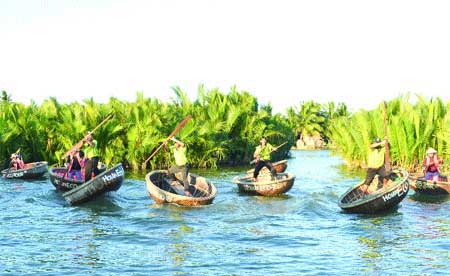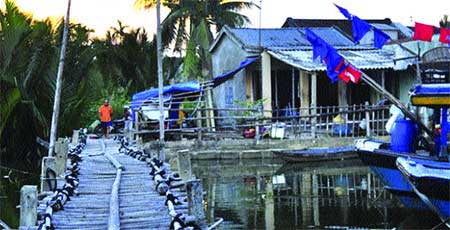
Float on: Tourists can ride bamboo boats called coracles through the forest swamps.
Cam Thanh Village outside Hoi An Town is a favourite eco-tour destination for visitors. They love its 30ha of nipa palm forest and handicrafts made from palm and bamboo.
Soon, they will have a choice of riding around on bamboo-frame bicycles being produced by a village craftsman – green bicycles in a green village.
The village, which has a population of 2,000, offers bicycle tours, trips in primitive coracles, floating trips among the palm trees and visiting craft people making traditional bamboo furniture.
Cam Thanh is an option for visitors visiting Hoi An along with craft villages making lanterns, silk goods, timber furniture and pottery. Visitors can pedal along 5km of winding flat roads around the tranquil village, just 3km from the major tourism hub of Hoi An. Bikes, available for rent in Hoi An, are the perfect stop-start way of travelling throughout the area. 
Eco-friendly: The village offers a range of sustainable bamboo transport options, on both water and land.
The nipa palm forest shadows the Thu Bon River, where tourists can explore the wetland ecological system in coracles, craft of woven bamboo covered with pitch that date back to prehistoric times. The forest swamps are home to shrimps, fish and bird life. Tourists can use nets or lines to fish from the odd little craft.
If they like, they can spend a full day in the forest. Lunch can be prepared on site, hopefully heaps of grilled fish and prawns caught in the morning.
Pham Vu Dung, a Hoi An tour operator, said the combination of bicycle rides and fishing from coracles was a unique combination that appealed to visitors.
For the past 100 years, villagers have been planting nipa palms to protect the village from the Thu Bon River when it floods and to make handicrafts. 
Simple life: A traditional thatched roofed house in Cam Thanh Village.
The forest, which is part of the world recognised bio-reserve Cham Island, has also helped protect the village from storms, while, at the same time, created a stable income for the villagers.
Craftsman Vo Tan Muoi, 71, and his son Vo Anh Tan, create unique bamboo furniture and can also build houses using bamboo and palm leaves for the roof and walls.
"Local people used to make their houses from bamboo and palm. A house with walls made of split bamboo panels and palm-leaf roof can be used for 30 years," Muoi said, adding that the structures kept cool in summer, but warm in winter.
He said new-style buildings had gradually replaced the old-style houses. But villagers preserve some old houses to please the tourists.
The old man said his family produces furniture, souvenirs and interior decorations from bamboo. Muoi's son, Vo Anh Tan, has even created a bamboo bicycle and unique decorations.
"I have replaced parts of the steel frame with bamboo for those who would enjoy such an unusual environmentally friendly vehicle in a green village," Tan said. "However, I just started production last year and the new design is still being tested."
Tan also creates many other objects from bamboo, including beds, sofas, jars, and an old manual telephone. The whole village is drawn into the craft work in its different stages.
Vo Tat Thang, 40, who began the trade at the age of 12, said the bamboo was soaked in water for six months before being left out to dry in the sun for 10 days. "The process helps eliminate termites and wood-borers. Palm leaves dry in about two weeks and can then be used," he said.
Thang said he and a group of 10 craftsmen often made traditional houses from bamboo and palm leaves to fill orders from around the nation. "We have built bamboo houses at many resorts, restaurants and cafes following orders from owners. The houses create are unique in the days of concrete and steel," he said.
"Each house can be completed in 15 days for a cost of VND400,000 (US$20) per square metre," he said. "We get local householders to finish the processes to save time and create more work for our neighbours," he said.
The traditional houses are free from iron. "All bamboo panels are tied together with bamboo string, while beams and posts are locked in with bamboo nails."
Huynh Anh Phien, 61, earns around VND100,000 ($4.8) a day from processing palm. "It's a hard job, but the craft earns more than rice farming. We plant palm trees and harvest the leaves after five years. The main crop is between February and June."
Vo Thi Thuong, 45, makes VND150,000 ($7) a day working in the palm forest cutting leaves and putting them out to dry. "I've lived well for 20 years by growing palms. They need careful care in the first five years to grow well," she said. "The forest protects the village from landslides during the October flood season."
Vice chairman of the city's people's committee, Truong Van Bay, said the green tours can not only provide income for villagers, but help preserve the district's green heritage. "There are plans to build a craft production centre on 15ha in Cam Thanh Village to display the arts and crafts we make," Bay said.
He said the centre would be near the village entrance, making it more convenient for tourists and villagers.
Dinh Thi Thu Thuy, head of the city's trade and tourism office, said Cam Thanh Village was the best local village to explore by bicycle. "The forest of nipa palm, which connects with Tra Que Village and Cua Dai beach, is a full-day tour option.
Tourists can also learn how to plant vegetables and rices with farmers in Tra Que before testing their skills on bamboo and palm furniture production at Cam Thanh," said Thuy.
She said Hoi An hosted 1.6 million tourists last year, including 600,000 foreigners, who enjoy its peace and beauty.
Mark Wyndham, who runs a motorbike adventure tour company based in Hoi An, said the town was safe and easy to live in.
"I lived for a long time in Ha Noi and HCM City, but Hoi An is the right location for me to do business. I find life here very comfortable and was given a residential permit from the city's administration," he said.
The evergreen rice fields, friendly people and quiet life in Cam Thanh inspired Jean Cabane, 64, from Nimes in France to settle in the area four years ago. Japanese Hirukawa Yuki found the ancient town a good place to live when he gave up the fast-paced life in Tokyo two years ago.
"Local people treat us like friends. There is no space between us. They shared our difficulties from the first days we moved to Hoi An. My neighbours even invited me to a party with their family for Tet (Lunar New Year) holiday, Yuki said. "Life is so easy. I love the peace and quiet and the smile of local people."
Meanwhile craftsman Muoi and his son keep producing bamboo furniture from their bamboo house in the centre of the village. Tan expects to soon finish two bamboo bicycles as prototypes for mass production. Vietnamnet |















